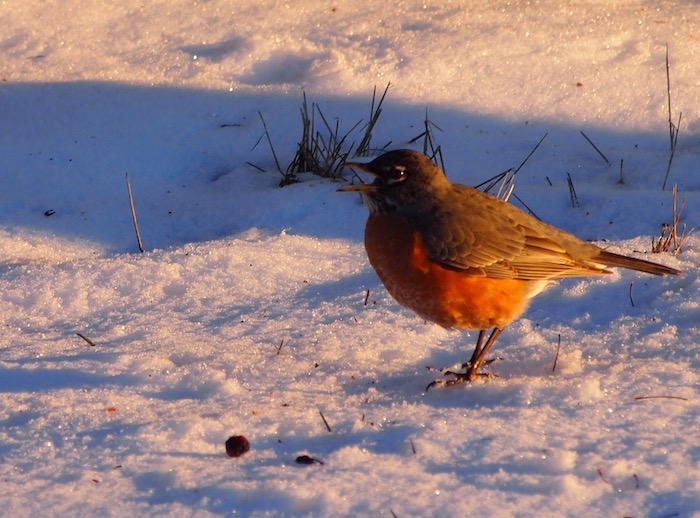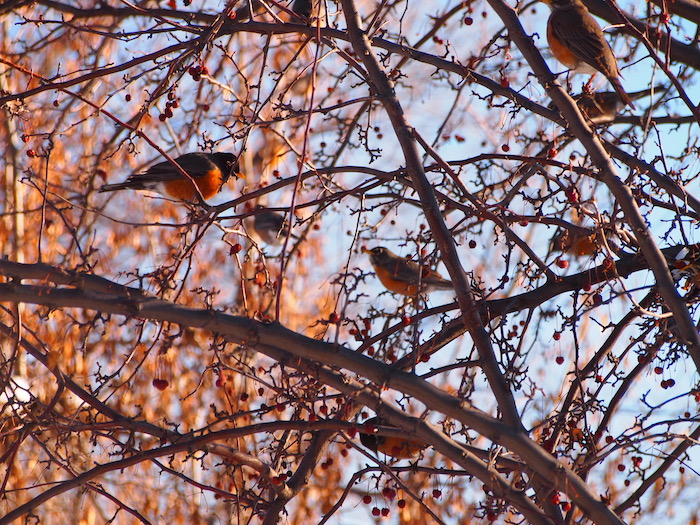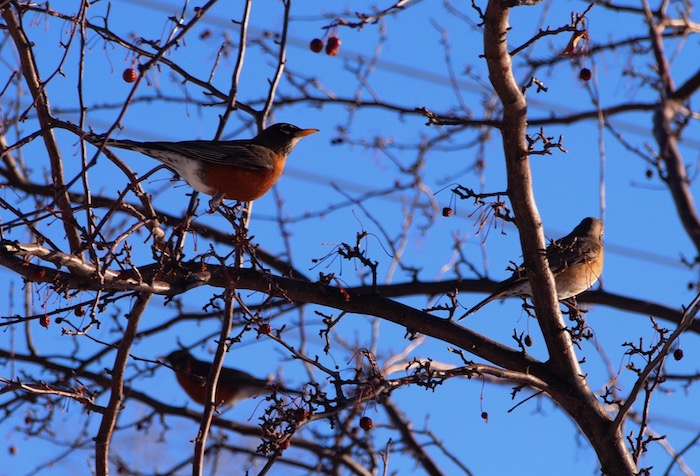
There are approximately 50 American robins in my front yard, a noisy, colorful flock centered around my crabapple tree. They have been partying for at least 24 hours, gorging themselves on the fruit and singling lustily.
These festive aggregations are a common feature of spring throughout the United States as the birds migrate. Robins are big colorful thrushes that do well in the Anthropocene. They like the same sorts of habitats we do: lots of grass and a few trees and shrubs, and the expansion of the suburban landscape has increased their numbers in the last several decades.
We often mistake rarity for value and disdain the common. Robins are sometimes victims of this reflexive snobbery. I too have caught a bird in the corner of my eye, only to turn away once I identified it as “just a robin.” So in celebration of the flock that is visiting me, I looked up American robins in four bird books: one from 1827, one from 1922, one from 1988, and one from 2019.

“The first land-bird seen by me, when I stepped upon the rugged shores of Labrador, was the Robin, and its joyful notes were the first that saluted my ear.” So writes John James Audubon in 1827’s Birds Of America. He then goes on to be disappointed that “numberless Indians” did not at once spring out of the woods to be his volunteer guides to the natural history of North America. Returning to the robins from his little White Man Snit Fit, Audubon tells us about their migratory flocks in March, adding that “Several persons may at this season stand round the foot of a tree loaded with berries, and shoot the greater part of the day, so fast do the flocks of Robins succeed each other. They are then fat and juicy, and afford excellent eating.” Back then, people ate robins on toast! The idea seems faintly disgusting now. But appreciating their flavor was not incompatible with appreciating them when alive as well. “Every one knows the Robin and his song,” Audubon writes. “Excepting in the shooting season, he is cherished by old and young, and is protected by all with anxious care.”
In 1922’s Western Birds, author Harriet Williams Myers points out that the robin’s breast is “by no means red” but actually a sort of brick-orange. Fair enough. Myers says they are among the earliest spring arrivals to the west coast, “enlivening the dreary month of March by their songs.” Myers bemoans that robins were, in her day, still frequently mown down in large numbers by market hunters. She expresses a hope that the passage of the Federal Migratory Bird Bill, just four years earlier, will end the “needless slaughter of our Robins.” And lucky for all of us, it did.
In 1988’s The Birders Handbook by Paul Ehrlich, David S. Dobkin, and Darryl Wheye, we learn that the robin often has two rounds of chicks each year, sometimes three. While adults love fruit, they feed their nestlings primarily insects. (It is for this reason that having a messy yard and planting native species that insects like is arguably better for birds than putting out seed—many baby birds need high-protein insects to thrive.) The book also mentions a post-Migratory Bird Act threat to the species: spraying of DDT to combat Dutch Elm Disease in the 1950s. Luckily, they came through that as well.
In 2019’s How to Know the Birds, by Ted Floyd (which comes out today and for which I provided an enthusiastic blurb), robins are the second bird introduced to the reader. Floyd challenges our reflexive dismissal of the species as ordinary and unremarkable. And indeed, now that we know all they have been through, their easy abundance seems all the more wonderful today. “The robin is one of the truly marvelous birds of our continent,” he writes. “The migrations of robins are stirring; their adaptability to different habitats is staggering; their easily observed family life is endlessly fascinating and, with no apologies for sentimentalism, heartwarming.”

In a couple of months, the merry revelers outside my window will pair up, build nests, breed, and lay three or or four of the most beautiful eggs in the world, a blue so striking, that we have named the color after the thing: robin’s egg blue. Note that finding a broken blue egg on the ground does not mean tragedy has occurred; the mother robin often pitches them out of the nest after her young have hatched. But not all nests are “successful”—rates vary from place to place. If a baby robin makes it to adulthood, it may live up to 13 years, flying north and south, partying and breeding and mothering and fathering—a nice long life for a songbird. Albatrosses can make it to 40, and they look like wise elders from the moment they lose their juvenile plumage. Robins don’t live nearly so long, nor look nearly so serious. They sing and they gorge themselves on fruit and they wrestle together in the treetops. They seem to be having a pretty good time. They are common but astonishing. I am so glad they didn’t all end up on toast, and that they are flourishing in my front yard. I feel honored by their visit.
What a lovely way to honor the robins, Emma! Enjoyed this immensely.
As I turn my compost pile over, the robins sit perched on the fence waiting for me to toss a juicy worm their way. It’s as if I’m playing fetch with a dog.
I have a feeling that Audubon thought he was seeing the European Robin, which is no relation to ours, which, as I’m sure you know, is a Thrush and closely related to the Bluebirds. Thanks for a lovely ode to a sometimes under-appreciated bird.
Thanks for this, Emma! Nicely done.
Love it! And also the oldest known albatross, Wisdom, is nearly 70 years old: https://www.npr.org/2018/12/07/674481057/wisdom-the-albatross-worlds-oldest-wild-bird-lays-another-egg
WHAT? 70 years old! That’s amazing.
Nice. Robins may be my favorite bird. I also like minivans.